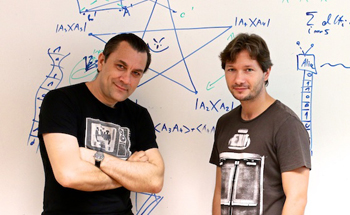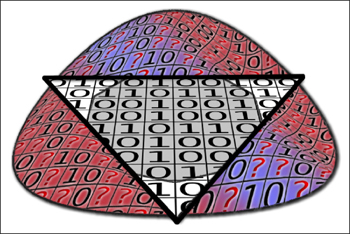
Quantum in context
This article first appeared on the FQXi community website. FQXi are our partners in our Information about information project and in our Who's watching: The physics of observers project.
What if the outcome of a coin toss depended on what you had for breakfast? As bizarre as it sounds a similar effect could hold sway in the quantum world.
Dagomir Kaszlikowski and Pawel Kurzynski, both physicists at the Centre for quantum Technologies (CQT) in Singapore, believe that this esoteric phenomenon, known as quantum contextuality, hasn't had its fair share of time in the Sun. If they have their way, and their theoretical explorations into this particular slice of quantum weirdness prove fruitful, they dream of opening doors to applications as bizarre as teleportation and time travel.

Dagomir Kaszlikowski and Pawel Kurzynski, Centre for Quantum Technologies, Singapore.
In 2014 Kurzynski and Kaszlikowski organised a conference at CQT, aptly subtitled "Trick or Treat," to investigate whether this effect could help to drive forwards quantum computing or have other practical applications. "This is definitely an interesting time for quantum contextuality, because right now it is going to be decided whether this topic is going to be elevated to mainstream physics, or remain a field for experimental metaphysicists and mathematicians," says Kurzynski.
The term "contextuality" simply refers to the weird way in which a property of a quantum particle can depend on the context of the experiments you do to investigate it, even if there seems to be no good reason why that should be so. "It's like the colour of your socks affecting the experiment," says Joseph Emerson, an FQXi member and quantum physicist at the University of Waterloo, Ontario, who also researches this area of physics. This doesn't hold true in the everyday macroscopic world: a given playing card in a deck is either black or red, and it stays that way regardless of whether anyone looks at it or not, or the way in which they look. This steadfastness does not always apply to quantum systems, where properties may not be set until they are observed, and when and how measurements are carried out can change the outcome of the experiment.
The famous theorem of contextuality was devised in the 1960s, around the same time as the theorem of non-locality — the formalisation of the idea that the observation of one particle can instantaneously impact the state of another entangled particle, even if it is very far away (the thing that Einstein dismissively called "spooky action at a distance"). Both sound a little crazy, but entanglement was confirmed experimentally in the 1980s. By the 1990s it became a useful tool for quantum encryption, and entanglement is now a buzzword in quantum computing because it could help computers to perform certain tasks much faster than conventional devices.
Contextuality, on the other hand, has developed much more slowly. The first experiment to test it wasn't proposed until the mid-2000s, and wasn't performed until 2011 and 2013. What is needed now, Kurzynski says, is a breakthrough to show that contextuality is just as important — and useful — as entanglement: "There have been few attempts, but personally I think that we are still waiting for something big."
Both Kurzynski and Kaszlikowski are originally from Poland. Kaszlikowski, the older of the two, started out in astronomy but moved to particle physics after being entranced by a picture of a bubble chamber. "I thought it was so cool to see something that's invisible and only leaves a trace," he says. Quantum physics held the appeal of being even more enigmatic. As Poland came out of its communist regime in 1990, Kaszlikowski wanted to use his science to see the world, which led him eventually to the centre in Singapore (which also, coincidentally, has a Polish director, Artur Ekert). Some years later, Kurzynski applied as a young scientist for a job; Kaszlikowski decided to give him a chance. "That paid off," Kaszlikowski says.
Kurzynski is from a scientific family: his mother was an astronomer and his father a biophysicist. "For a long time I was thinking of pursuing literature. But in the end I decided on science, in part because my parents were so happy pursuing their dreams," he says. Quantum physics was particularly appealing, Kurzynski adds, because it was even more bizarre than the strangest parts of astronomy, like black holes: "That strangeness is the fun part."
The Don Quixote of contextuality
The two turned their attention to contextuality just a few years ago, after Adán Cabello, a researcher at the University of Sevilla, in Spain, who carried out one of the experiments confirming contextuality, pushed the field into the spotlight. "He's like the Don Quixote of contextuality," says Kaszlikowski. "People in the past thought he was crazy, but he put this field on the map and made it sexy."
Since then, there have been increasing hints of contextuality's usefulness. In June 2014, researchers including Emerson published a paper proposing that contextuality provides the "magic" that makes quantum computers so powerful. People often say that the speed of a quantum computer relies on the fact that the qubits exist as both a 0 and a 1 at the same time, and thus a series of qubits can essentially do multiple different calculations simultaneously. But this is an oversimplification, and debate continues about how to best explain the quantum advantage. "I don't know that contextuality is the only ingredient contributing to the speed up," says Kaszlikowski. "It could be more complicated. This is just the tip of the iceberg."

This figure represents the magic-state model of quantum computing. States in the triangular region are not magic. States outside the triangle exhibit contextuality and could be a useful resource for quantum computation. Credit: University of Waterloo.
A better understanding of contextuality might not only help to build quantum computers but could crack open even weirder applications. "One of the consequences of having much stronger quantum contextuality would be a kind of transfer of information backwards in time," admits Kaszlikowski, though he says this is highly speculative and one of their tasks might be to prove this possibility false. Quantum devices are also useful for generating truly random numbers, for use in encryption, and this could be another practical application for contextuality.
"For years, working on contextuality was not perceived as something important," says Cabello. "Now there is increasing evidences that contextuality is behind quantum speed-up, nonlocality, the fundamental principles of quantum theory and all that we consider puzzling and exciting about it. Kaszlikowski and Kurzynski belong to those that are establishing these connections."
Kurzynski, Kaszlikowski and colleagues have been making some interesting advances, with the help of an FQXi grant of almost $100,000 (which also supported their recent CQT conference). They have shown, for example, how to use information theory to see strong differences between quantum and classical behaviour when three particles are entangled with each other.
Along with Cabello, they have extended a rule of monogamy: a given particle can have non-locality or contextuality, but not both at the same time. The implications of that have yet to be worked out. "This is something we don't really understand yet," says Kaszlikowski. They are now working on a paper showing a partial solution to the problem of "device independent" testing for quantum contextuality.
As researchers continue the search for that killer app, Kurzynski and Kaszlikowski pride themselves on doing things differently. "Being Polish we like to disobey authority," laughs Kaszlikowski. "We're looking at it in a very different way from other people. But now we're being invited to conferences and people are starting to like what we do."
In the meantime, Kaszlikowski is also a keen film maker, and has made a few short films — some inspired by quantum mechanics, and also starring Kurzynski. In one, Collapse, a hit man offers his target a strange reprieve by using a quantum gun — so long as the hit man doesn't look, he says, the target will be both dead and alive at the same time. Another, the quantum teleportation crime thriller Seeing without looking, has just won one of three $10,000 top prizes in FQXi's inaugural video contest. "I think that this could be an effective and different way to popularise quantum physics," says Kaszlikowski. "Let's see what happens."
Comments
Anonymous
Can't you proofread a bit, please?